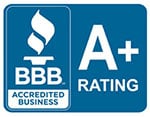How Low-E Glass Can Keep Your Houston Home Cool
Labor Day has come and gone, but the hot weather is still lingering in Southeast Texas. If you’re fed up with the heat, you’re probably wondering what you can do to help keep the scorching Houston sun from cooking your home and raising your energy bills.
Replacing your windows with more energy efficient models can help you bigtime in this quest to stay cool. But once you search around the Internet — and get bombarded with terms like U-Factor, VT and SHGC — you’ll probably feel flustered, confused and even upset.
But don’t worry. We’re here to tell you that only one window factor really matters when you’re looking for replacement windows that can help keep your Houston home cool. Oh, and we’ll also tell you why it’s so important.
Intrigued? Then read on!

Window glass naturally emits a lot of solar energy.
What is Emissivity?
OK, if you’ve read this heading, you probably realize that the factor we’re talking about is emissivity. If you’re not sure what that is, don’t worry. We’ll explain it.
Emissivity defines the amount of solar heat brought through (or emitted through) a surface — such as a window. The higher emissivity a window has, the more solar energy it lets through.
Why is this important? Well, even on hot days where your windows are closed and the AC is on at North Pole strength, solar energy is being emitted through your windows. That energy is really hot (remember, the sun is full of fiery gases), and the inside of your home can really start to cook if too much solar energy is emitted.
Do you ever wonder why the areas of a home near windows feel so warm on scorching summer days? Well, wonder no more. This emissivity factor explains this situation. And if you have windows that allow your home to fill with energy faster than a football stadium fills up with fans on game day, your energy bills might skyrocket as you struggle to keep cool.
However, there are windows designed to keep these issues from affecting you and your Houston home — all thanks to a revolutionary type of glass.

Low-E glass is deigned to deflect a lot of solar energy aimed at it.
Glass That Reduces Solar Heat in Homes
There are energy efficient windows out there that can block most solar heat as effectively as bouncers can restrict access to a packed nightclub. The secret weapon for many of these windows? Low-emissivity (Low-E) glass.
Low-E glass looks much like other window glass, but acts like tinted glass. Essentially, it deflects a lot of solar energy that hits it, while still letting most of the light through. This allows you to be able to maintain those beautiful outdoor views from your windows, bring natural light into your home and avoid getting fried by solar heat. It’s like having your cake and eating it too.

Low-E glass can deflect more solar energy than regular glass (NOTE: Some windows with Low-E glass let in significantly less solar energy than this diagram indicates)
How Low-E Glass Works
Why is Low-E glass so effective? As previously mentioned, it deflects a good deal of solar energy and heat that hits it. This might sound simple at first, but it counters the general properties of glass that’s exposed to heat.
Much like metal, glass conducts heat. That means it warms up to ridiculous temperatures when it’s exposed to heat. This is why you shouldn’t drink hot coffee in a glass, or touch the windshield of your car on a sizzling July afternoon.
Since glass conducts heat so quickly, heat can also travel through glass quite easily. This is why the areas of the inside your home near windows feel so hot on days when the mercury skyrockets.
Of course, if your windows are built with Low-E glass, you won’t be feeling the heat as much. Since much of the incoming solar energy is being deflected away from the home, only a portion of that energy and heat is cooking your window like a steak on the grill.
The numbers back this up. For instance, Cardinal’s LoE-366 glass has a Solar Heat Gain Coefficient (SHGC) of 0.27. That means that only 27% of solar energy is making its way through these windows. By comparison, many clear, single-pane windows have an SHGC of 0.86 — meaning they’ll let a whopping 86% of that energy into your home.
Low-E glass can also block out about 75% of ultraviolet (UV) rays. While you most likely don’t have to worry about getting a sunburn indoors with any window, UV rays emitted through less efficient windows can cause pictures and furniture to fade. This won’t be a problem if you have windows with Low-E glass around your home.

If you have a lot of windows in your home, installing Low-E glass models is the way to go.
Why You Need Low-E Glass
It’s absolutely crucial to get windows with Low-E glass for Houston area homes. Installing this windows will help lower your energy bills, while increasing your level of comfort and piece of mind. These windows might cost more than some other models, but the investment is definitely worth it.
If you’re looking to add windows with Low-E glass to your home, turn to Best Investments Siding and Windows. We’ve been installing replacement windows across the Houston area since 1977, and we have an A+ rating from the Better Business Bureau. For a free, no pressure consultation, click here or call (281) 852-1866 today.




Recent Comments